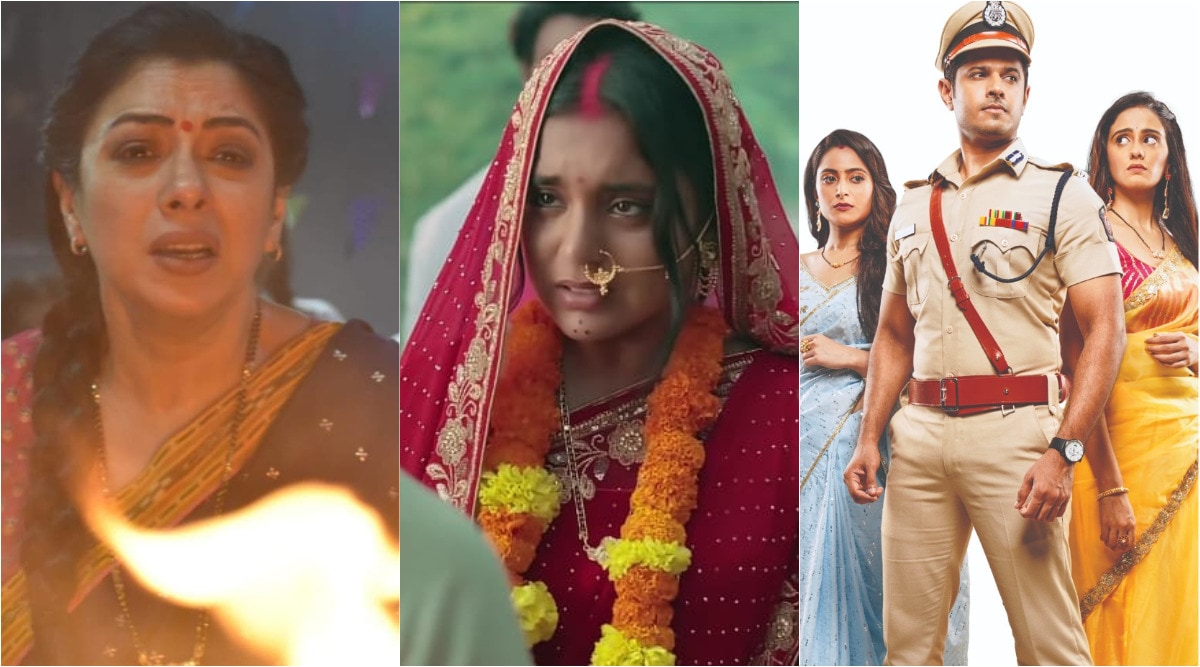Editor’s Note: FII’s #MoodOfTheMonth for November, 2021 is Popular Culture Narratives. We invite submissions on various aspects of pop culture, throughout this month. If you’d like to contribute, kindly email your articles to sukanya@feminisminindia.com
Indian daily soaps have been perpetuating the misogynist structures that we live in. From being immemorially caught up in the saas bahu drama depicting women as essentially docile and submissive, to storylines confining women within households and normalising them taking up the double burden of having a career (only in conventional jobs) as well as running a family, daily serials have been cementing gender roles.
Nowadays, the dominant theme of these soaps is anchored on the patriarchally established myth – “aurat hi aurat ki sabse badi dushman” (a woman’s greatest enemy is another woman herself). The tv shows gaining the highest target rating (TRP) like Anupama, Gum Hai Kisi k Pyaar mei, Udaariya, and Imile to name a few, have all been following the same thematic pattern.
Why do such stories still rule the daily soap roost? Feminist philosopher and author Simon de Beauvoir answers for us.

Common Plot: Women fighting for a man
As we can see, the plot of most prime time daily soaps remain rooted in the animosity between two women, most often over a man. Of the two women, one is always the present wife of the man, and the other mostly remains an extra marital lover or a former flame.
The wife is portrayed as homely, carrying the burdens of parampara, pratishtha, and anushasan, (tradition, customs, discipline) along with izzat, lihaz and sharam (chastity, honour). The other woman is caricatured as evil – the house breaker, playing all sorts of gimmicks to woo the man, create trouble and insult his wife, take revenge on her for being in his life, and to morally degrade her.
Simone de Beauvoir explains that the destiny society traditionally offers women is marriage. Even today, most women are, were, or plan to be married, or they suffer from not being so. Marriage is the reference by which a woman is defined, whether she is frustrated by, disgusted at, or even indifferent to this institution. Thus, the desperation to have a man is largely a desperate attempt to ascribe value to the woman herself

Why does this tussle happen? Simone de Beauvoir explains how a woman is established as the ‘other‘ by positioning her existence contingent to a man. She remains in a constant position of dependence. Simone argues that history has shown that men have always held all the concrete positions of power. From patriarchy’s earliest times, they have deemed it useful to keep women in a state of dependence, concretely establishing a woman as the ‘other‘.
In this way, the women in these soaps remain dependent as well as prioritise the man by fighting one another to have more space and say in his life. This ensures that the male characters remain paramount in power as well as decisive stature.
Marriage: The traditional destiny of women
Since women are shown as lacking in capacity to be enough by their own selves, they are always shown as people who are desperate to have a man. They are portrayed to invariably need masculine support, security and surety in life to feel safe and complete. Even educated and employed women are depicted in the same light.
Moreover, the age old ‘cunningness‘ and ‘shrewdness‘ associated with working women and the incapacity of a working woman to maintain a “happy family” finds a new modification here. The working women in these plots themselves do not value their jobs and try to compete with the other home makers in the plot to gain acceptance. They can be seen taking pride not in their independence, but in following misogynist traditions and confirming to the oppressive power structures of family.
If you type “friendship of Simone de Beauvoir with….” on the search bar, Google will direct you to Jean Paul Sartre, and only after some specific searches you will find some mention of her deep and enriching friendship with Rosa Luxemburg and Emma Goldman. There is a need to break this popular culture pattern of pitting women against women and centralising men as the most important pursuit of women’s lives

Kavya (from Anupama), a professional can be seen going to the length of neglecting her profession just to win over Vanraj and pull down Anupama. Another well educated character Patralekha (from Gum hai Kisi Ke Pyaar mei) consciously makes the decision not to do any job and throws herself on Virat to prove her love. Yet again, Malini (from Imlie) who happens to be a college lecturer goes to the extent of taking advantage of Aditya and making out with him without consent to get pregnant, in order to secure her marriage and to remain in his life.
Simone de Beauvoir explains that the destiny society traditionally offers women is marriage. Even today, most women are, were, or plan to be married, or they suffer from not being so. Marriage is the reference by which a woman is defined, whether she is frustrated by, disgusted at, or even indifferent to this institution. Thus, the desperation to have a man is largely a desperate attempt to ascribe value to the woman herself. Women are thus trained to bear as much as they can, serve, and remain marriageable so that they have social acceptance.
Also read: The Evolution Of Hindi Television And Their Portrayal Of ‘Indian Values’
Tearing sisterhood apart
The best way to carry forward the institution of patriarchy is by not letting its worst sufferers build a sense of solidarity among themselves. Thus, most of these narratives thrive on the enmity between women. When women keep fighting among themselves, will they ever be able to unionise and fight patriarchy together? No.
Meanwhile, the men in these narratives do nothing and sometimes are portrayed as the victims, caught between two unreasonable women. Even the side characters, mostly women, can be seen sympathising with the ‘helpless’ men and looking down at either or both of the two leading women. Female characters sympathising with other female characters is minimal.

There is a need to break this popular culture pattern of pitting women against women and centralising men as the most important pursuit of women’s lives.
In reality, we know how important female friendships are, and how such solidarities impact the betterment of the socio-economic stature of women. Popular culture, especially Indian soaps try hard to control the narratives about women to suit the male conscience, thereby erasing and ignoring the lived experiences of women.
Also read: What Happened To The Progressive Tamil Serials We Grew Up With?
Anjali is pursuing a master’s in Political Science at the University of Delhi. She likes exploring the world through the pages of her books and hitting misogyny through the ink of her pen. Political in instinct, she takes keen interest in political theory and the politics in India
Editorial Note: This article originally contained an image of Simone De Beauvoir with Rosa Luxemburg and Emma Goldman. It has been removed and the article has been updated since the image was cited to be digitally manipulated and fake





The picture must be fake. Rosa Luxemburg was killed in 1919. At that time, Simone de Beauvoir waa only 11 years old (Emma was 50), so there’s no way that those three women are Rosa, Simone, and Emma.
Thank you, we have have rectified the same.
When for the first time I saw people enjoying these daily soaps I was so shocked watching how these people can normalise such stories where women had no jobs except fighting for men when all I can see women around me fighting so hard to build a career but finally it’s nice some people do talk about this topic!
Our society needs to change🤟
Writer is right on the mark about some daily soaps being promoters of misogyny.
This needs to stop!
People enjoy watching 2 women fighting that to over a man, TRP of these daily soaps proves this. And then on the other side these people talk about women empowerment (sad).
Well written Anjali❤
Keep writing.